
Rome Metro Guide: Everything You Need to Know (Map, Lines, Tickets, Hours & Travel Tips)
Planning a trip to Rome and wondering how to get around the Eternal City without wasting time in traffic? Good news, the Rome metro is one of the easiest and fastest ways to reach the city's top attractions without getting stuck in the chaos of Roman streets.
While the Rome subway network isn’t as large as Paris or London’s, it’s incredibly useful for quickly getting to iconic spots like the Colosseum, Piazza di Spagna, Vatican City, or Termini train station.
In this complete guide, you'll find everything you need to know to navigate the Rome metro system like a pro:
- A downloadable Rome metro map (including monuments)
- A breakdown of the metro lines and key stations
- Info on Rome metro ticket prices, passes, and how they work
- Metro hours, frequency, and tips for avoiding crowds
- The best apps to help you get around easily
I’ll also show you how to get to Fiumicino and Ciampino airports using the metro and connecting transport.
Whether you're visiting Rome for a weekend or a full week, this step-by-step metro guide will help you move around like a local, and make the most of your stay. Ready to explore how the Rome subway system works?
Contents
- 1 Rome Metro Map
- 2 Rome Metro Lines
- 3 Rome Metro Ticket Price
- 4 Where to Buy Rome Metro Tickets: Machines, Tabacchi & Apps
- 5 Rome Metro Hours: Opening Times & Night Schedule
- 6 Rome Metro & Airport Transfers
- 7 Best Apps for Getting Around on the Rome Metro
- 8 The 4 Main Rome Metro Stations Every Visitor Should Know (Plus Time-Saving Tips)
- 9 Practical Tips for Using the Rome Metro
- 10 Future Projects of the Rome Metro
- 11 Rome Metro FAQ: Your Top Questions Answered
Rome Metro Map
If you’re heading to Rome, one of the first things you’ll want to have on hand is a Rome metro map. Even though the network is smaller than in Paris or London, it’s still super handy for getting to all the must-see monuments quickly and easily.
How to download the Rome Metro Map PDF
Before your trip, I highly recommend downloading a Rome metro map in PDF format. That way, you’ll have it saved on your phone and can access it even without an internet connection, which is especially useful when you’re underground or haven’t activated your local SIM card yet.
- 👉 Click here to download the Rome metro map PDF (you’ll find it for free on official tourism websites or at ATAC, Rome’s public transport operator).
- You can also grab a free paper version at major stations like Termini or Spagna.
Bonus tip: Some hotels in the city center also offer printed subway maps of Rome at the front desk, don’t hesitate to ask when you check in!
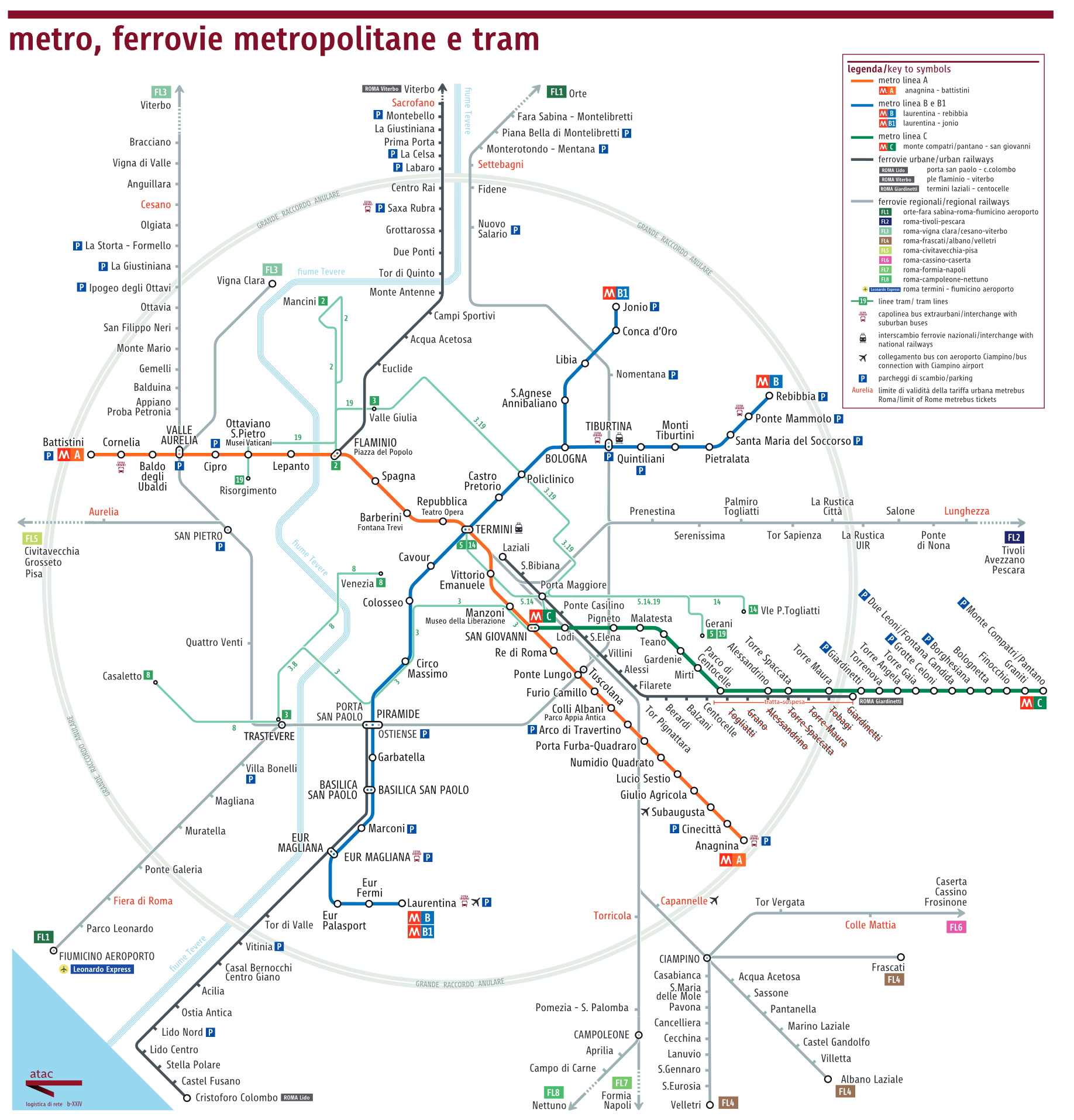
👉 My tip: For a complete and always up-to-date view of the Rome subway, head over to the official ATAC website. It’s the city’s public transport authority, and their site offers detailed Rome metro maps in PDF format to help you easily get your bearings on the system.
Here are the direct links to download the Rome metro map by line:
- Line A – Download the PDF map here
- Line B/B1 – Download the PDF map here
- Line C – Download the PDF map here
And there’s more! The ATAC site also provides maps of the Rome rail network and tram lines. Perfect if you’re planning to combine different transport options while exploring the Eternal City. These tools will save you a lot of time once you’re on the ground.

Interactive Rome Metro Map
Prefer using your phone to get around? You’re in luck because the Rome metro map is available interactively through apps like Google Maps, Moovit, or the Rome Metro app on Google Play.
With these tools, you can:
- Plan your route in real time
- Check connections with buses and trams
- Estimate travel time to reach landmarks like the Colosseum or Vatican
These apps are incredibly handy, especially if you're short on time or want to avoid the hassle of figuring things out underground. They make using the Rome subway system simple, fast, and stress-free.
Rome Metro Map with Landmarks
Want to make sightseeing even easier? Grab a Rome metro map with major landmarks marked. It’s the best way to quickly figure out which stop to use for top attractions.
Here are some useful metro stops for famous sites:
- Colosseum → Colosseo Station (Line B)
- Vatican Museums & St. Peter’s Basilica → Ottaviano Station (Line A)
- Piazza di Spagna → Spagna Station (Line A)
- Roman Forum & Palatine Hill → Colosseo Station (Line B)
- Trevi Fountain → Barberini Station (Line A) + 10-minute walk
- Basilica of St. John Lateran → San Giovanni Station (Lines A & C)
Pro tip: Print a special tourist-friendly Rome subway map or save a screenshot to your phone. Many paper travel guides already include a handy map with monuments, perfect for offline use.
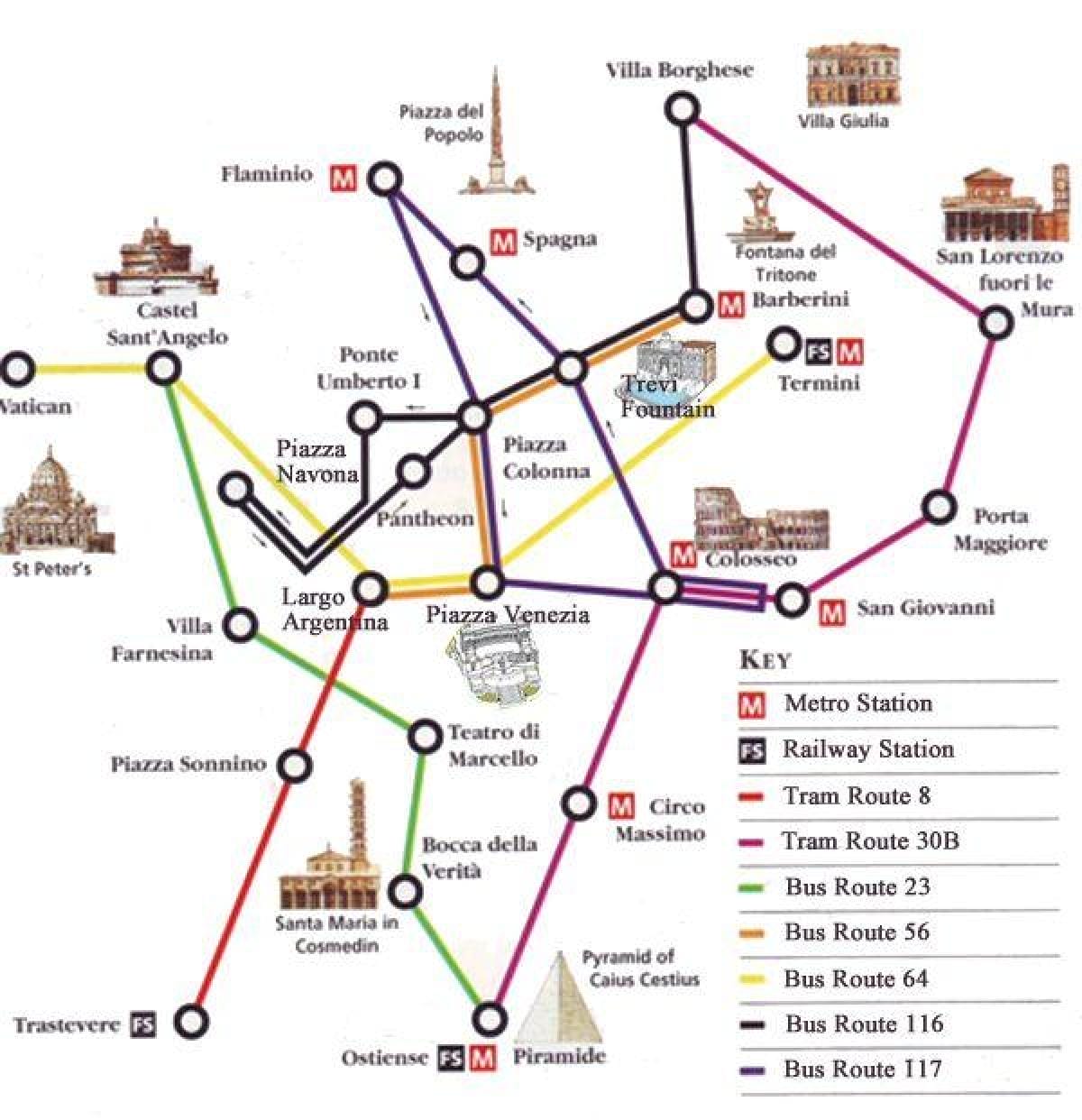
Rome Metro Lines
The metro system in Rome is way easier to navigate than in cities like Paris or London. There are only three main metro lines (A, B, and C) plus an additional line currently under construction.
Let’s break them down one by one, starting with the most useful for travelers.
Line A (Orange – 27 Stops)
If you only remember one metro line in Rome, make it Line A.
Marked in orange on the map, it runs east to west, connecting the station Battistini in the west to Anagnina in the east. It intersects Line B at Termini, the city’s central train station.
Line A is by far the most tourist-friendly metro line in Rome, and for good reason, it passes close to many of the city’s most iconic landmarks.
Here are the must-know stops on Line A:
- Ottaviano Station → This is the main station for visiting the Vatican. Once you exit, you’re right in the lively Prati district, just a short walk from St. Peter’s Basilica. It’s also the best stop for the Vatican Museums and the Sistine Chapel.
- Spagna Station → This stop brings you to the famous Spanish Steps (Piazza di Spagna) and the elegant Via Condotti, one of the most stylish shopping streets in the city.
- Barberini Station → The closest metro stop to the Trevi Fountain. Pro tip: visit it both day and night — the vibe is completely different!
- San Giovanni Station → Just steps away from the majestic Basilica of St. John Lateran, one of Rome’s four major basilicas and a less touristy, but deeply impressive, historical site.
Complete list of Metro Line A stations in Rome :
Wondering where Line A can take you in Rome? Here's the complete list of stations from west to east:
- Battistini
- Cornelia
- Baldo degli Ubaldi
- Valle Aurelia
- Cipro
- Ottaviano -San Pietro – Vatican Museum
- Lepanto
- Flaminio
- Spagna
- Barberini (Trevi Fountain)
- Repubblica – Teatro dell Opera
- Termini (Change to Line B)
- Vittorio Emanuele
- Manzoni – Museo della Liberazione
- San Giovanni – change to line C
- Re di Roma
- Ponte Lungo
- Furio Camillo
- Colli Albani
- Arco di Travertino
- Porto Furba
- Numidio Quadrato
- Lucio Sestio
- Giulio Agricola
- Subaugusta
- Cinecitta
- Anagnina
👉 Traveler Tip: If your hotel or Airbnb is located near Line A, you’ll be able to get to most of Rome’s must-see monuments without too much walking, making your sightseeing smooth and efficient.
Line A Rome Metro Map 👇
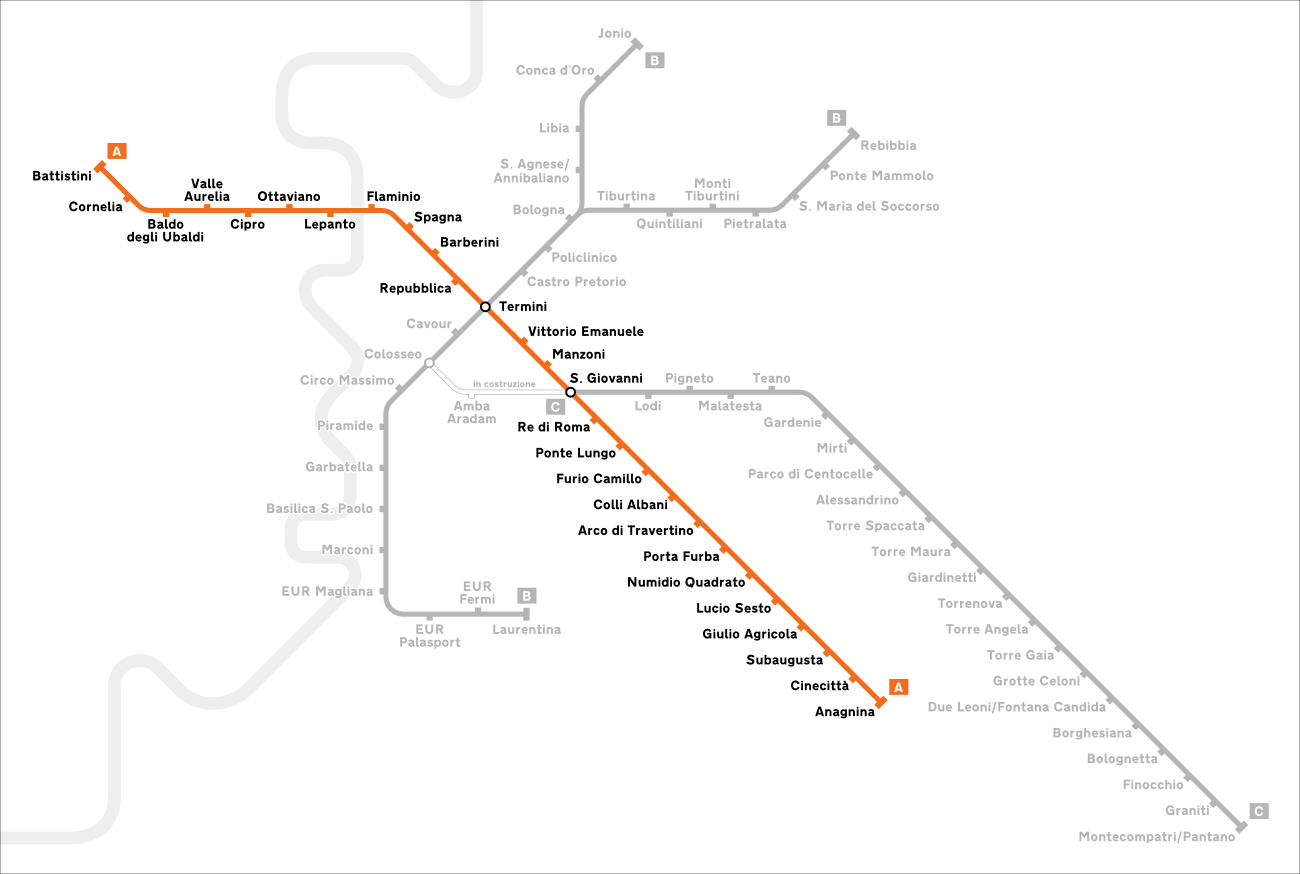
Line B (Blue – 26 Stations)
Rome Metro Line B is the second main underground route in the Eternal City, easily spotted on maps thanks to its blue color. It runs from Rebibbia and Jonio in the north to Laurentina in the south, cutting right through central Rome.
Quick reminder: Line B intersects with Line A at Termini, Rome’s main train station. If you're arriving or leaving by train, chances are you’ll pass through here.
So why is Line B essential for curious travelers like you? Because it connects you to some of the most iconic ancient sites in Rome. Here are the key stops you shouldn’t miss:
- Colosseo → No surprise here: this is the star stop on Line B. As soon as you step out of the station, you're face to face with the Colosseum, one of the most visited monuments in the world. The Roman Forum and Palatine Hill are just steps away. Get your camera ready!
- Cavour → A lesser-known gem, this station is perfect for discovering Monti, one of Rome’s coolest neighborhoods. Think cobblestone streets, cozy trattorias, vintage shops and great wine bars, ideal for a post-sightseeing break.
- Piramide → Your gateway to Testaccio, a local favorite for food and nightlife. From here, you can also catch the Roma-Lido train line that takes you to the beach if you're craving some sea air.
- EUR Fermi → Want to see a different side of Rome? Head to EUR, a modern district built during Mussolini’s era, known for its grand boulevards and striking architecture like the Palazzo della Civiltà Italiana (a.k.a. the “Square Colosseum”).
Full List of Rome Metro Line B Stations
Here’s the complete list of stops on Line B (including the B1 branch):
- Rebibbia
- Ponte Mammolo
- Santa Maria del Soccorso
- Pietralata
- Monti Tiburtini
- Quintiliani
- Tiburtina
- Jonio
- Conca d’Oro
- Libia
- Sant’Agnese
- Bologna
- Policlinico
- Castro Pretorio
- Termini – change to A
- Cavour
- Colosseo
- Circo Massimo
- Piramide
- Garbatella
- Basilica S Paolo
- Marconi
- Magliana
- Palasport
- Fermi
- Laurentina
👉 Good to Know: Line B splits into two branches in the north: B (to Rebibbia) and B1 (to Jonio). Always double-check the direction on the platform screen before boarding, it’ll save you from going the wrong way!
Line B Rome Metro Map 👇

Line C (Green – 24 Stations)
Rome Metro Line C is the newest addition to the city’s subway network. You’ll find it marked in green on the Rome metro map. Although it's still under construction and doesn’t yet reach the city center, it can be useful if you're staying in eastern Rome or want to explore off-the-beaten-path neighborhoods.
Currently, Line C connects San Giovanni (near the city center) to Pantano in the far east. While it’s not as popular as Lines A and B for tourists, a few stations might interest you:
- San Giovanni → This is where Line C connects with Line A, making it the best access point for visitors. It's also just steps from San Giovanni in Laterano, one of the most important basilicas in Rome, and actually the real cathedral of the city (not St. Peter’s!).
- Pigneto → This hip, alternative neighborhood is a great place to experience a more local, artistic side of Rome. Expect street art, craft cocktail bars, and a laid-back boho vibe.
- Parco di Centocelle → Worth a stop if you’re into green spaces or want to see a more residential side of the capital.
- Pantano → This is the current end of the line, far out in the suburbs. Mostly used by locals, it’s not typically relevant for tourists, unless you’re staying nearby.
Traveler Tip: To make the most of Line C, connect through San Giovanni station and pair it with Line A. This saves time and avoids long detours.
Full List of Rome Metro Line C Stations
Here's the complete list of stations currently open, and those under construction:
- Fori Imperiali-Colosseo – transfer to B. Under construction
- Giorgio Marincola under construction
- San Giovanni – transfer to A
- Lodi
- Pigneto
- Malatesta
- Teano
- Gardenie
- Mirti
- Parco di Centocelle
- Alessandrino
- Torre Spaccata
- Torre Maura
- Giardinetti
- Torrenova
- Torre Angela
- Torre Gaia
- Grotte Celoni
- Due Leoni-Fontana Candida
- Borghesiana
- Bolognetta
- Finocchio
- Graniti
- Monto Compatri-Pantano
Expansion Update: Line C is currently being extended. Once completed, it will reach Piazza Venezia, placing it right in the historic heart of Rome. That will be a game-changer for travelers. But until then, it’s most useful if your accommodation is on the eastern side of the city.
Line C Rome Metro Map 👇

Rome Metro Ticket Price
Taking the metro in Rome is one of the cheapest and easiest ways to get around the Eternal City. But with several types of tickets and passes (single ride, daily pass, tourist cards…), it can be tricky to know which one to choose.
So, how to buy tickets for the Rome metro ? Here’s everything you need to budget your Rome transport costs wisely.
Rome Metro Single Ticket (BIT)
If you only plan to take the metro once or twice in a day, the single metro ticket. Officially called BIT (Biglietto Integrato a Tempo) it is your best option.
- Price: €1.50 → One of the cheapest metro fares in any major European capital!
- Validity: 100 minutes from the time you validate your ticket.
- During that 100-minute window, you can take as many buses or trams as you like.
- You can only use one metro ride per ticket (even if you switch lines during the ride).
- Kids under 10 travel free as long as they’re accompanied by an adult with a valid ticket.
Example: If you validate your ticket at 9:15 AM, it remains valid until 10:55 AM. You could take the metro to the Colosseum, then hop on a bus to reach the Vatican, all on the same ticket. Just keep in mind: once you exit the metro, you can’t re-enter with the same ticket.
👉 The BIT ticket is ideal if you plan to walk most of the day and just use the Rome metro for longer distances or to get back to your hotel at night.
⚠️ Important Tip: Always validate your ticket before boarding. Ticket inspectors are common, and fines for unvalidated tickets start at €55, and can go up if you refuse to pay on the spot.
Multi-Ride Tickets and Travel Passes
If you’re planning to take the Rome metro multiple times a day, you can save quite a bit by using a multi-ride ticket or a transport pass instead of buying single tickets each time.
MULTI-BIT: The Smart Ticket for Multiple Rides
The MULTI-BIT is a great option if you plan to use public transport frequently in a single day. It’s an integrated ticket available in packs of 2, 3, 5 or 10 rides, and it works a little differently than regular tickets.
- Each time you validate it, you get 100 minutes of unlimited travel starting from that moment.
- During those 100 minutes, you can take the bus, tram, metro (one continuous metro ride only), and even urban trains.
- Once the 100 minutes are up, simply re-validate the ticket to start a new 100-minute period.
- Depending on the pack you choose (2x, 3x, 5x, or 10x), you can repeat this process up to 10 times.
So instead of buying a new ticket for each journey, you can use the same MULTI-BIT ticket throughout the day. Super handy and more economical.
- Price: From €3.00 to €15.00 depending on the number of rides
- Validity: 100 minutes per validation, up to 10 times
- Valid on: Bus, tram, metro, and urban trains (within the Rome public transport network)
👉 Travel tip: The MULTI-BIT is perfect if you plan a busy day of sightseeing. For example, you could use it in the morning to get to the Vatican, again in the afternoon for the Colosseum, and once more in the evening to return to your hotel, all with the same ticket.
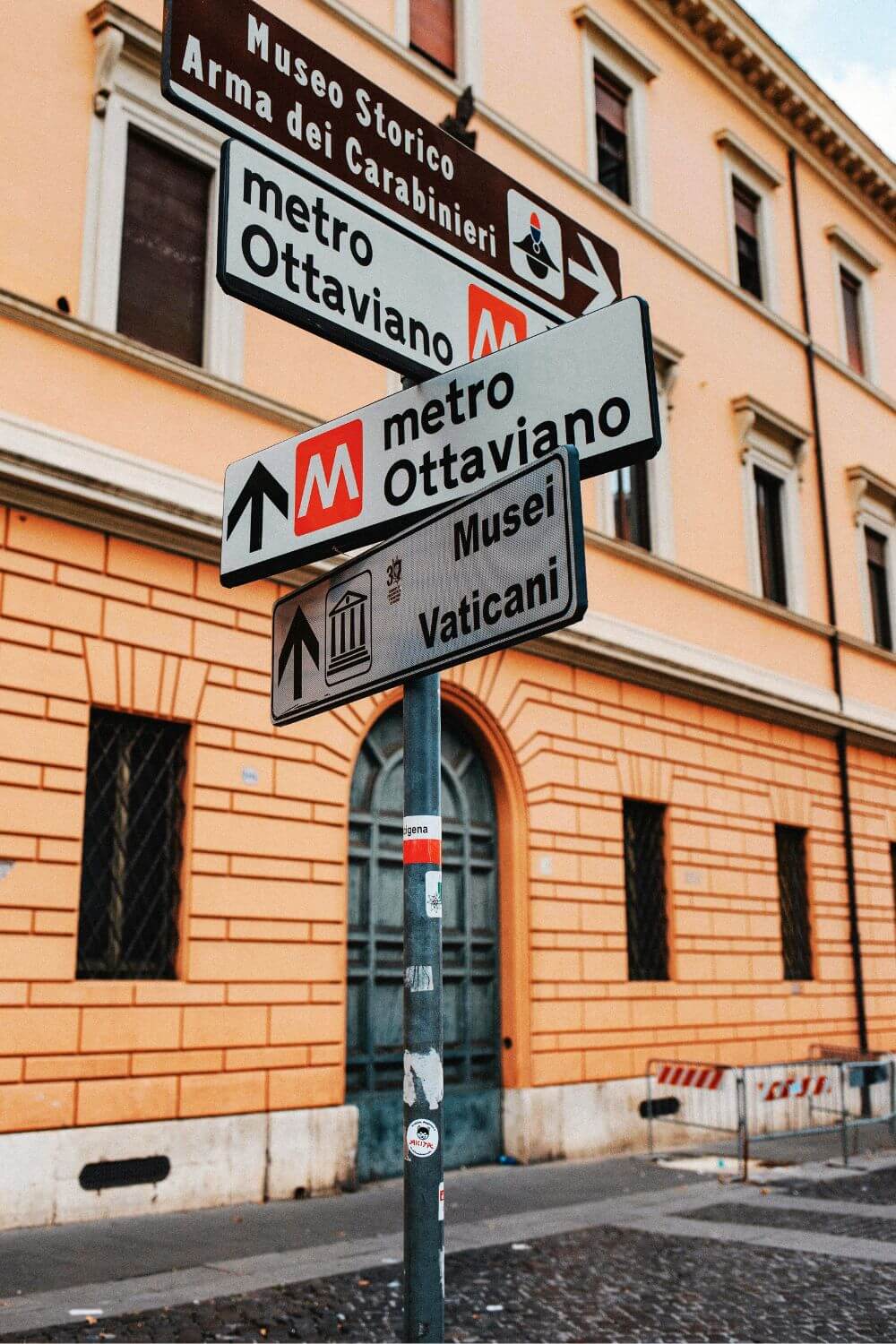
ROMA24, ROMA48, ROMA72: Unlimited Transport for 1, 2 or 3 Days
These passes are ideal if you're planning to move around a lot during your stay in Rome.
- ROMA24 (€8.50) – Unlimited travel for 24 hours
- ROMA48 (€15.00) – Unlimited travel for 48 hours
- ROMA72 (€22.00) – Unlimited travel for 72 hours
👉 Think of it as a magic ticket: you validate it once, and then you can hop on and off the metro, buses, and trams as much as you want for the duration you choose. No need to buy multiple tickets every time you move.
Real-life example: If you validate your ROMA48 on Tuesday at 10:00 AM, it will be valid until Thursday at 10:00 AM. Perfect for covering two full days of sightseeing without stress.
Tip: These passes are super convenient for busy itineraries where you're visiting landmarks across the city, like the Colosseum, Vatican, and Piazza Navona, all in one day.
CIS Weekly Pass (Carta Integrata Settimanale)
Staying in Rome for a full week? The CIS pass (Carta Integrata Settimanale) is your best friend.
- Price: €29.00
- Validity: 7 consecutive days from the first validation
- What it includes: Unlimited travel on metro, buses, and trams across Rome
If you're planning a typical 5 to 7-day trip, this is the most cost-effective option. After about 16 rides, it already pays for itself.
💡 My tip: Go for the CIS pass if your Rome hotel or Airbnb is a bit outside the city center and you expect to use the metro daily. You’ll travel stress-free without worrying about ticket costs every time you leave.

Rome Metro Pass and Unlimited Public Transport
If you want to explore Rome without worrying about individual tickets, getting a Rome metro pass or a Rome tourist pass with unlimited transport is your best option. Some even include top attractions and skip-the-line access!
Why choose an unlimited transport pass?
- Total freedom – hop on and off the metro, bus or tram as much as you like
- Clear budget – know exactly what you’ll spend on transport
- Time saver – no need to find a ticket machine or tabacchi each time
It’s perfect if you have a packed itinerary or if your hotel is located a bit outside the city center.
Main Transport & City Passes in Rome
Several tourist passes include unlimited use of the Rome metro, along with free entry to attractions and skip-the-line access. Here are the main ones you should consider:
Roma Pass (48h or 72h)
Includes:
- Unlimited travel on metro, bus, and tram
- Free entry to 1 or 2 museums/monuments (depending on duration)
- Discounts at other attractions
Example: With a 72h Roma Pass, you can visit the Colosseum and Borghese Gallery for free, while using public transport as much as you like.
💡 Tip: The Roma Pass is worth it if you're combining sightseeing with public transport.
Omnia Card (Rome & Vatican Pass)
More expensive, but very complete.
Includes:
- Unlimited public transport
- Roma Pass
- Skip-the-line access to top Vatican sites (Vatican Museums, St. Peter’s Basilica, Sistine Chapel)
- Hop-on Hop-off bus tour
👉 The Omnia Card is worth it if you want to visit both Rome and Vatican City without wasting time in queues.
Comparison: Rome Metro Passes vs Tourist City Passes
Pass Type | Includes | Price |
BIT | 100 minutes | €1.50 |
ROMA24 | Unlimited transport for 24h | €8.50 |
ROMA48 | Unlimited transport for 48h | €15.00 |
ROMA72 | Unlimited transport for 72h | €22.00 |
CIS | Unlimited transport for 7 days | €29.00 |
Roma Pass | Transport + 1 or 2 museums + discounts | €36.50 (48h) / €58.50 (72h) |
Omnia Card | Transport + Roma Pass + Vatican + Hop-On Hop-Off Bus | €149 (72h) |
💡 My personal advice:
- In Rome for 2–3 days? Get the Roma Pass 72h to combine free museums and transport.
- Staying a full week? The CIS is the most budget-friendly option.
- Want to see everything fast (Rome + Vatican)? Go for the Omnia Card, it saves you hours in lines.
Where to Buy Rome Metro Tickets: Machines, Tabacchi & Apps
In Rome, you’ve got several easy ways to buy your metro tickets or transport passes. The key is knowing where to go so you don’t waste time, or panic at the turnstiles.
1. Ticket Machines in Metro Stations
You’ll find automated ticket machines in every metro station.
Advantages:
- Multilingual interface (including English and French)
- Accepts both cash and credit cards
- Sells all types of tickets: BIT, ROMA24, ROMA72, CIS, and more
Tip: Keep some coins on hand. Some machines don’t accept large bills or may reject certain credit cards.
2. Kiosks and Tabacchi Shops (Tobacco Stores)
Look for the iconic white “T” sign on a blue background, that’s your new best friend.
Why it's useful:
- Great alternative to busy metro stations
- You can buy single tickets and multi-day passes
⚠️ Heads up: Some Tabacchi close early in the evening or on Sundays.
👉 Pro tip: While you’re there, ask for a free Rome metro map. Many kiosks keep them behind the counter.
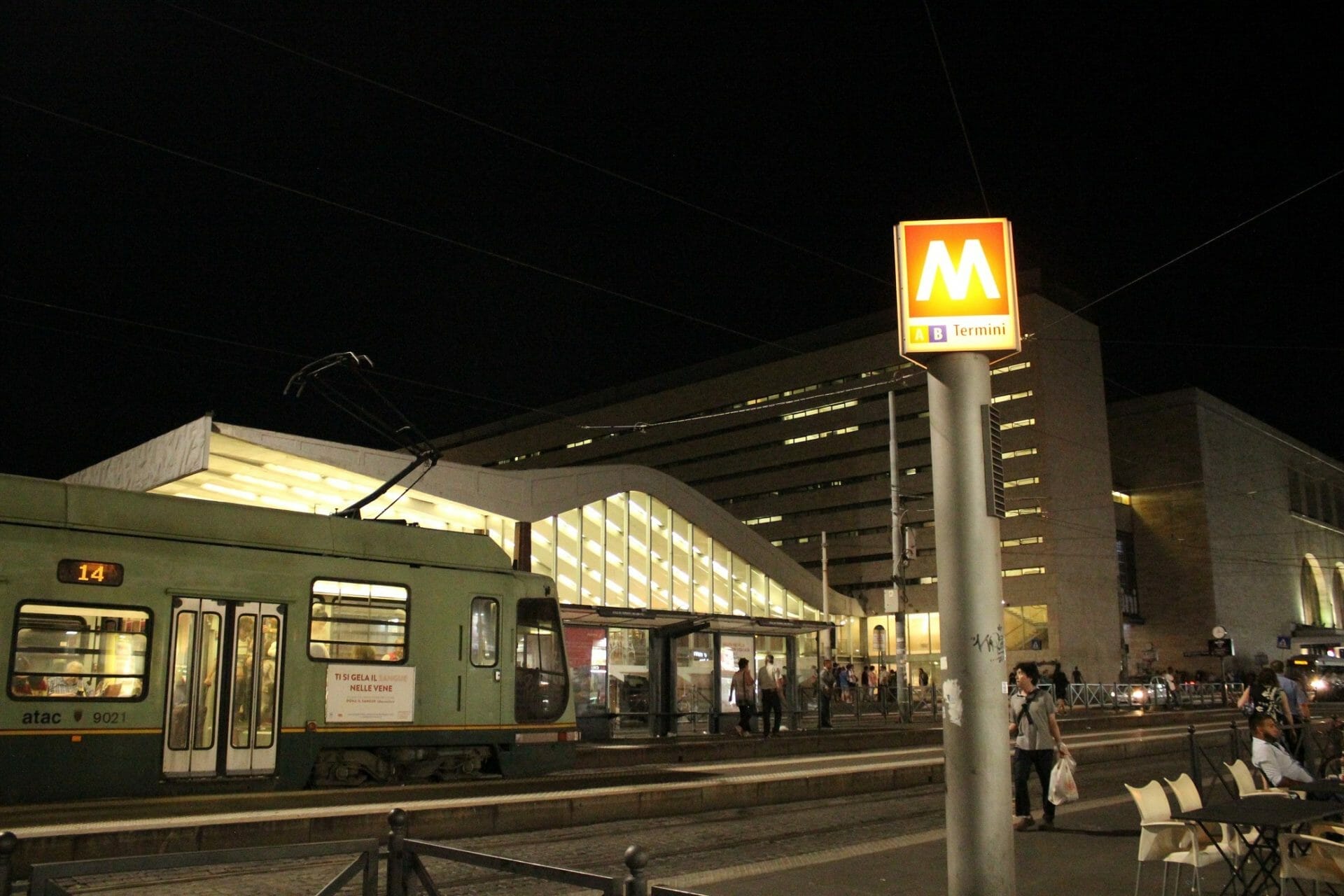
3. Via Mobile Apps
Rome is going digital and that includes public transport.
Recommended apps:
- MyCicero or Tabnet: buy and validate your metro tickets right from your phone.
- ATAC Roma: the official app for the city’s transport network, great for checking real-time schedules and recharging your pass.
💡 Tip: Get an eSIM for Rome or check your data plan before your trip — it’ll save you the hassle of hunting for Wi-Fi.
4. On Board the Bus (Only as a Last Resort)
Yes, you can buy a ticket directly from the bus driver — but:
- It’s often more expensive
- The driver might not have change
👉 Only use this option if you really had no time to get a ticket beforehand.
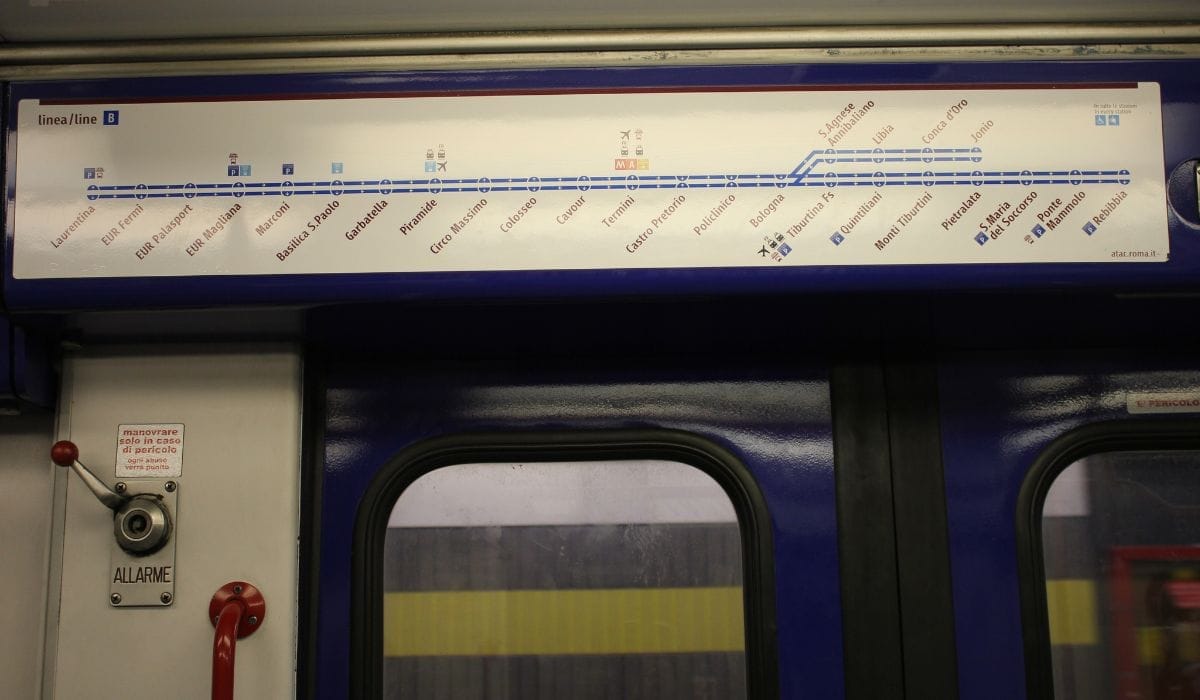
Rome Metro Hours: Opening Times & Night Schedule
Planning to explore Rome by metro? Then knowing the Rome metro operating hours is a must. The network doesn’t run 24/7, and opening times vary slightly depending on the day.
Weekday Hours (Monday to Thursday)
From Monday to Thursday, Rome’s metro runs:
- From 5:30 AM to 11:30 PM (all lines: A, B, and C)
- First trains depart around 5:30 AM from terminal stations
- Last trains leave the central stations just before 11:30 PM
👉 That gives you plenty of time to visit the main attractions, enjoy dinner, and still get back to your hotel stress-free. As long as you're not partying until dawn!
Tip: Use the official route planner to check your last train time based on your location.
Weekend & Public Holiday Schedule
Good news if you're a night owl!
- Fridays and Saturdays → extended service until 1:30 AM
- Sundays and public holidays → same hours as weekdays: until 11:30 PM
Practical tip: Planning a late dinner or night out in the city? Make sure you check the last train time ahead of time. After hours, you can still get home using Rome’s night buses, look for routes marked with an “N”.
Days | Opening Hours |
Monday to Thursday | from 5:30 a.m. to 11:30 p.m. |
Friday and Saturday | from 5:30 a.m. to 1:30 a.m. (next day) |
Sunday and Public Holidays | from 5:30 a.m. to 11:30 p.m. |
Rome Metro Frequency
- During peak hours (7:00 – 9:30 AM and 5:00 – 8:00 PM): a train every 3 to 5 minutes.
- During the day: every 7 to 10 minutes.
- In the evening after 9:00 PM: around every 10 to 15 minutes.
👉 Tip: Line A is often busier than lines B and C, especially between Termini and Ottaviano (the Vatican section). Plan a bit ahead if you need to be on time.
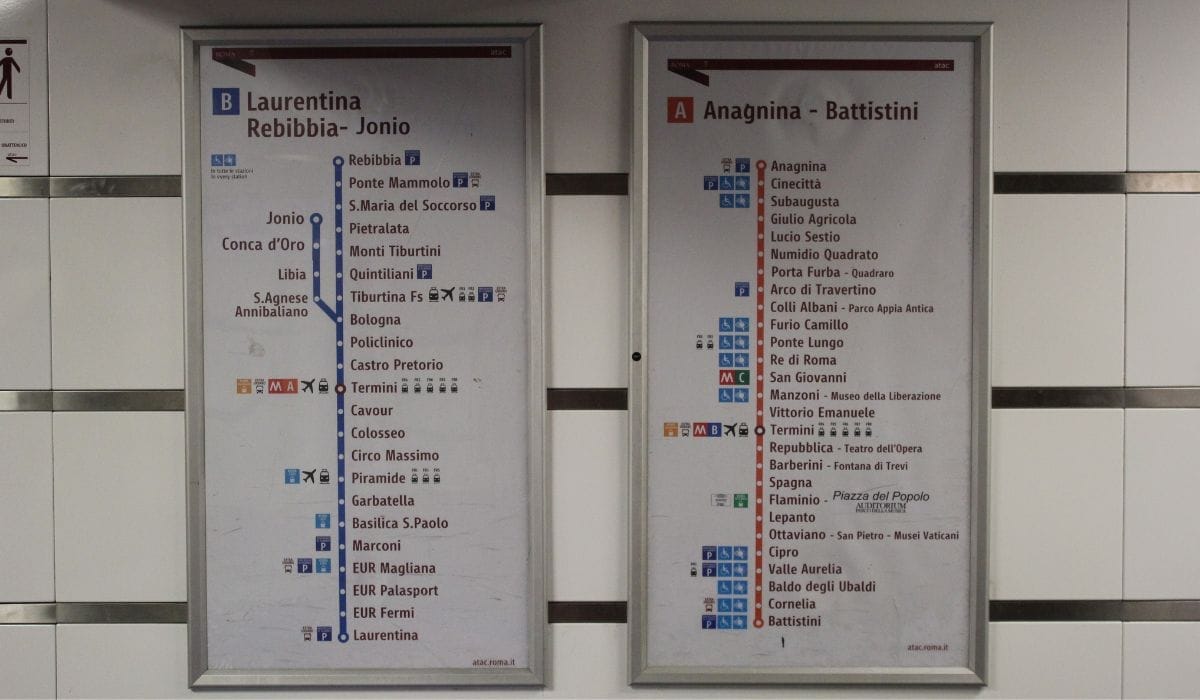
Rome Metro Closures & Maintenance Work
Like any major capital, Rome regularly upgrades and maintains its metro system.
- Partial closures or night works aren’t unusual, especially on Line C, which is still being extended.
- Most service updates are announced on the official ATAC website and via the ATAC mobile app.
- If a section of the metro is temporarily closed, replacement buses are usually provided. But keep in mind they may be slower due to traffic.
⚠️ Important to know: Rome is an ancient city, so some construction work takes longer than expected. That’s because many projects involve archaeological excavations. Frustrating for travelers, perhaps, but it’s also part of the Eternal City’s unique charm.
Rome Metro & Airport Transfers
Arriving in Rome by plane? The Rome metro doesn’t connect directly to the city’s airports, unfortunate, I know! But don’t worry: with a mix of metro + train or bus, getting to Rome city center from the airport is still easy and affordable.
How to Get to Fiumicino Airport (Leonardo da Vinci – FCO)
Rome’s main airport is Leonardo da Vinci Airport, commonly known as Fiumicino (FCO). To reach it from the city center, here’s your best option:
Fastest Option: Leonardo Express Train
From Termini Station (served by metro lines A and B), hop on the Leonardo Express, a direct train to Fiumicino Airport.
- Duration: 32 minutes
- Frequency: Every 15 to 30 minutes
- Price: Around €14
- Bonus: It’s a non-stop service, ideal if you’re in a hurry or carrying luggage.
Budget Option: FL1 Regional Train
From metro line B (stations like Tiburtina or Ostiense), you can catch the FL1 regional train to Fiumicino Airport.
- Duration: Around 45 minutes
- Price: Around €8
- Tip: A smart option if you’re staying near Tiburtina or Ostiense.
- Less convenient if you need to go all the way to Termini, since the FL1 doesn't stop there.

How to Get to Ciampino Airport (CIA)
Ciampino is Rome’s second airport, mainly used by low-cost airlines like Ryanair.
Metro + Bus Combo (Cheapest Option)
- Take metro line A to the end of the line at Anagnina.
- From there, hop on a COTRAL or SIT bus to the airport.
- Total journey time: about 45 minutes
- Cost: €1.50–€2 for the bus + €1.50 for the metro ticket
Direct Shuttles from Termini (Simple & Popular)
- Several private companies (like Terravision, SIT, etc.) offer direct shuttles from Termini Station to Ciampino.
- Duration: around 40 minutes (depending on traffic)
- Price: roughly €5–€6
👉 Pro tip: If you have an early flight or arrive late at night, the direct shuttle from Termini is the easiest choice, since the metro doesn’t run 24/7.
Rome Airport Tips: What to Know Depending on Where You Land
Fiumicino Airport (FCO)
- Best for a quick trip into the city – the Leonardo Express is the easiest option.
- Staying near Trastevere or Ostiense? The FL1 regional train is cheaper and more convenient.
Ciampino Airport (CIA)
- Plan a bit of extra time, especially during rush hour – buses can get delayed by traffic.
- Travelling light? The metro + bus combo is the cheapest way.
- Got heavy luggage? Choose a direct shuttle from Termini for less hassle.
Traveler tip: Book your Leonardo Express or airport shuttle online in advance to skip the lines and secure your seat, especially during high season.
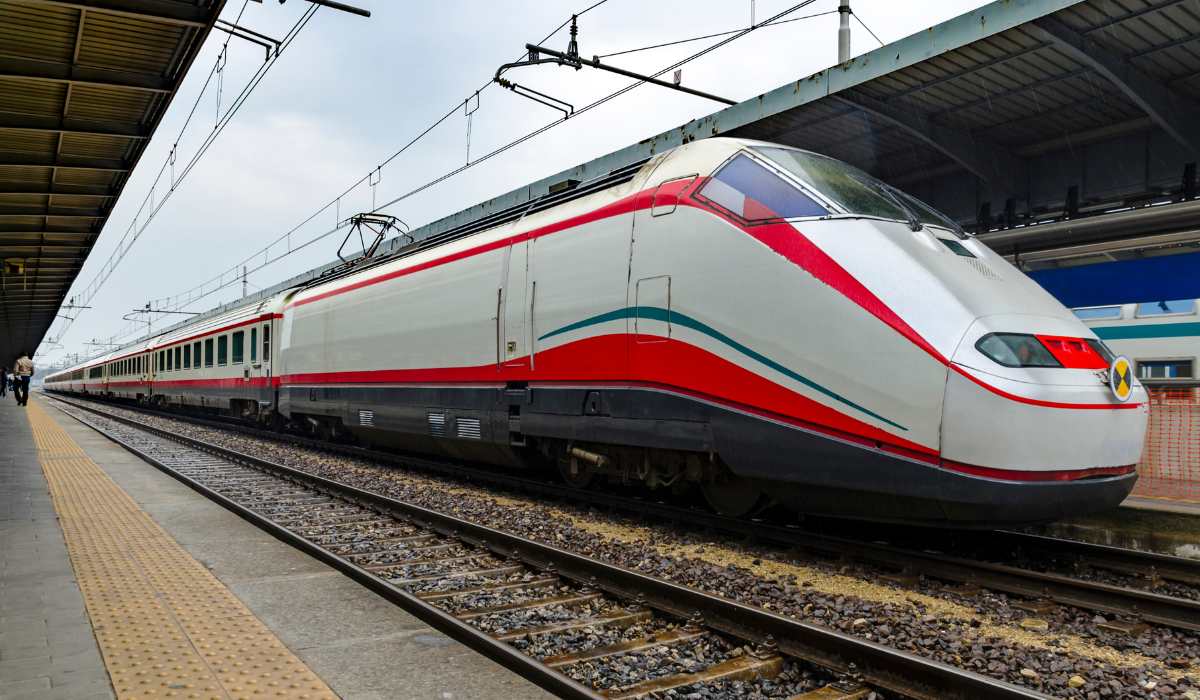
Best Apps for Getting Around on the Rome Metro
Let’s face it, travelling without a good app these days is like visiting Rome without trying gelato… technically possible, but why would you?
Here are the best apps to make your metro experience in Rome smoother:
- Roma Mobilità (Official App) : The go-to app for public transport in Rome. It covers metro, buses, trams, and even local trains. You can check real-time schedules, service updates, and even buy tickets directly through the app.
- Trenitalia : If you’re using the Leonardo Express or FL regional trains to get to/from the airport, download Trenitalia. It lets you buy and validate tickets on your phone, no need to queue at the machines.
- Moovit : A favourite among travellers! Moovit offers real-time route suggestions, adjusts for delays and transfers, and is available in multiple languages. Great if you’re new to Rome.
- Google Maps : Simple but effective. Google Maps handles Rome’s public transport system well, including metro and buses. Note: You’ll need an internet connection for full functionality.
- Citymapper : Tourist-friendly with a clean and intuitive interface. It’s slightly less detailed than Moovit in Rome, but perfect for quick metro planning.
👉 Before you go: Download your favourite apps and also save a PDF map of the Rome metro (scroll up, we’ve got one for you). It might just save your day if your phone dies or the 4G gets spotty.
Pro tip: Not a fan of juggling multiple apps? Use the Moovit + Google Maps combo. You'll get both smart route planning and live navigation.

The 4 Main Rome Metro Stations Every Visitor Should Know (Plus Time-Saving Tips)
Rome’s metro only has 3 lines, but it still connects to some key stations that make sightseeing a lot easier. Here are the must-know stops to help you plan your trip without wasting time.
Termini Station: The Main Hub (Train & Bus Connections)
Termini is the beating heart of Rome’s metro system. It’s the only station where lines A (orange) and B (blue) intersect, making it a central stop for most travelers.
But Termini is much more than just a metro station:
- Main train station: From here, you can catch high-speed trains to Florence (1h30), Naples (1h10), or Milan (3h).
- Airport connections: Grab the Leonardo Express to Fiumicino (non-stop, 32 minutes, every 15–30 minutes) or hop on low-cost buses to Ciampino.
- Bus and tram hub: Ideal for reaching neighborhoods not served by the metro, like Trastevere.
Traveler tip: The area around Termini isn’t the most charming (and can feel a bit chaotic), but staying nearby can be a smart choice if you want to:
- Move around Rome easily,
- Have quick access to both airports,
- Find better hotel deals than in the historic center.
👉 Heads up: Like in any big station, keep a close eye on your belongings, especially in metro corridors or near ticket machines.
In short, Termini is Rome’s main transport gateway and a super practical base to explore the city (and beyond).
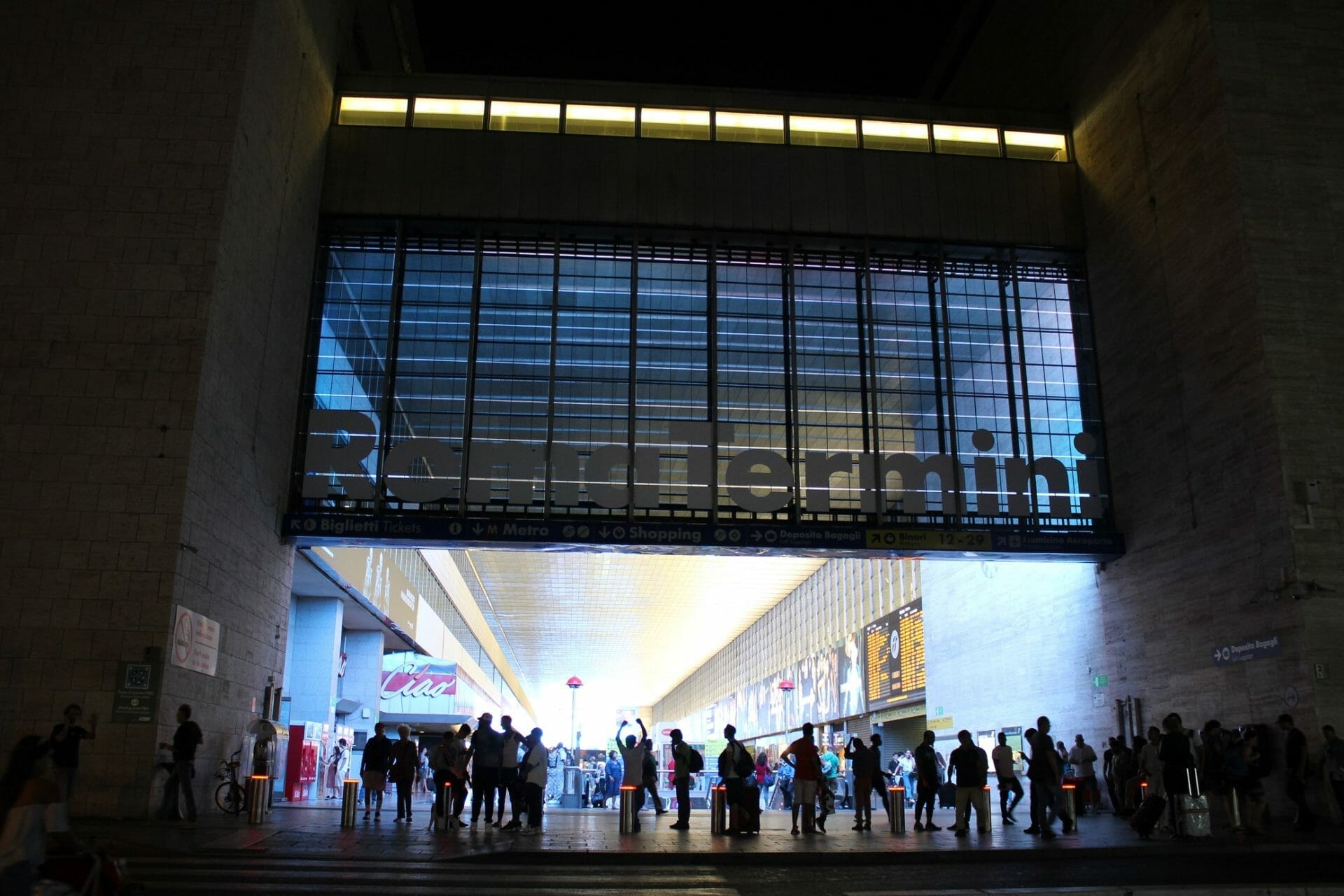
Colosseo Station: Direct Access to the Colosseum and Roman Forum
If you want to dive straight into ancient Rome, Colosseo station (Line B – blue) is your must-stop. As soon as you step out of the metro, you’re face-to-face with the Colosseum, and trust me, the “wow” effect is instant. You’ll be reaching for your camera in no time!
But that’s not all:
- Just across the street, you’ll find the Roman Forum and Palatine Hill, two of the most impressive archaeological sites in the city.
- You’re also right next to Via dei Fori Imperiali, a majestic avenue lined with ruins that leads directly to Piazza Venezia and the massive Victor Emmanuel II Monument (nicknamed the “typewriter”).
💡 Handy tip:
- Colosseo station gets very busy, especially in the morning and early afternoon. Try going early or later in the day to avoid crowds.
- Ticket checks are frequent at this station, so keep your Rome metro ticket or pass handy.
- Looking for a relaxing break after your visit? Climb up to Colle Oppio Park, just above the station. It offers stunning views of the Colosseum and a much calmer vibe.
👉 For photo lovers: The sunset light on the Colosseum is pure magic. Thanks to Colosseo station, you can get there at just the right time — with minimal walking.
In short, Colosseo isn’t just convenient — it’s easily one of the most breathtaking metro stations in Rome, where every exit feels like a leap back in time.

Ottaviano Station: Best Stop for the Vatican
If visiting the Vatican is on your Rome itinerary, make sure to remember Ottaviano – San Pietro – Musei Vaticani station (Line A – orange). It’s the most convenient stop to reach Vatican City easily, without the hassle.
As soon as you exit the station, you’re just:
- 5 minutes on foot from the main entrance to the Vatican Museums, home to the Sistine Chapel and endless art galleries.
- 10 minutes’ walk from the majestic St. Peter’s Basilica and St. Peter’s Square, the spiritual heart of the Vatican.
💡 Pro tips for visiting the Vatican from Ottaviano:
- Take the “Viale Giulio Cesare” exit to head straight toward the Vatican Museums.
- Arrive early in the morning to beat the crowds (and take advantage of the metro — much faster than traffic-heavy buses).
- Lines for the Vatican Museums can be endless. If possible, book your skip-the-line ticket or Vatican Pass online in advance.
- For lunch or a coffee afterward, check out the Prati neighborhood around the station. It’s full of authentic trattorias and far from the tourist traps near the Basilica.
Why choose Ottaviano and not another station for the Vatican?
- Cipro station (also on Line A) is close too, but Ottaviano is the most straightforward and intuitive stop for most travelers.
- It’s also a great starting point if you want to combine your Vatican visit with a walk around the elegant Prati district.
Bonus tip: In the evening, take a walk around the beautifully lit St. Peter’s Basilica, it's magical. Then hop back on the metro at Ottaviano without a long walk back.
In short, Ottaviano is THE Rome metro station you want for the Vatican, especially if you're trying to save time and energy during your trip.

Spagna Station: Best Stop for Piazza di Spagna
Spagna station (Line A – orange) is one of the most iconic stops on the Rome metro and for good reason. As soon as you step outside, you're right at the foot of the famous Piazza di Spagna, one of the most photographed squares in the city.
In just a few steps, you’ll reach:
- The Spanish Steps (Scalinata di Trinità dei Monti): 135 legendary steps where people love to sit, snap photos, or enjoy a gelato (though locals would prefer you don’t picnic on the steps 😉).
- The Barcaccia Fountain, designed by Bernini’s father, perfect for a quick photo stop.
- Rome’s luxury shopping district, including Via dei Condotti, with storefronts from Gucci, Prada, Valentino, and more (window shopping here is part of the experience!).
- Villa Borghese, just a 10-minute walk away, ideal for a peaceful escape from the crowds.
💡 Practical tips for visiting from Spagna:
- Avoid peak times (late afternoon and weekends) — the station is small and the square gets crowded fast.
- Use the “Piazza di Spagna” exit to arrive directly in front of the Spanish Steps.
- Want a perfect photo? Come early in the morning (around 8–9 AM) for soft light and fewer people.
- For a panoramic view, climb the steps to the Trinità dei Monti church, the view over Rome is worth the effort.
👉 Pro tip: From Spagna, you can walk to the Trevi Fountain in under 15 minutes. It’s a scenic stroll through charming Roman alleyways, perfect for combining two must-see spots in one outing.
In short, Spagna station is ideal if you want to dive straight into Rome’s romantic and glamorous vibe, with easy access to monuments, upscale shopping, and beautiful walks.

Other Useful Rome Metro Stations for Tourists
Beyond the major stops like Termini, Colosseo, Ottaviano, and Spagna, the Rome metro has several other stations that can make your sightseeing much easier. Here are some lesser-known, but super useful, metro stops to keep in mind:
- Barberini (Line A): Dreaming of seeing the famous Trevi Fountain? This is the closest station. Once you exit, it’s just an 8-minute walk to this Baroque masterpiece. Good news: the station reopened in 2023 after long-term renovations.
- Cipro (Line A): Just one stop after Ottaviano, this station is a smart alternative for reaching the Vatican Museums. Many travelers get off here to avoid the crowds at Ottaviano and enjoy a quieter walk along Via Cipro to the museum entrance.
- San Giovanni (Lines A & C): This is a handy transfer station between Line A and Line C. Bonus: right outside is the stunning Basilica of San Giovanni in Laterano, the cathedral of Rome and a hidden gem often overlooked by tourists.
- Circo Massimo (Line B): Perfect for checking out the ruins of the Circus Maximus, the ancient Roman stadium. While you're in the area, stroll through the peaceful Aventine Hill and don’t miss the Orange Garden (Giardino degli Aranci) for a romantic view of St. Peter’s Basilica.
- Lepanto (Line A): Located between Ottaviano and Flaminio, this station is great if you're staying in the elegant Prati district. It’s close to the Tiber River and surrounded by charming local eateries, away from the tourist crowds.
- Piramide (Line B): Ideal for reaching the Testaccio district, known for its nightlife and authentic Roman cuisine. From here, you can also hop on the regional train toward Ostia and Rome’s beaches.
- Flaminio (Line A): Get off here to explore the grand Piazza del Popolo, one of Rome’s most impressive squares. From there, walk up to Villa Borghese via the Pincian Terrace (Terrazza del Pincio), it offers one of the best panoramic views in Rome.
In short: Rome’s metro map may look simple, but knowing these key stations can save you time and help you avoid long walks under the Roman sun. Planning your visits around them makes getting around the Eternal City way more efficient!

Practical Tips for Using the Rome Metro
Got your Rome metro ticket ready and downloaded your Rome metro map? Perfect! But before heading into the tunnels, here are a few useful tips to make your ride smoother and stress-free.
Ticket validation and inspections
In Rome, buying a ticket isn’t enough : you must validate it.
- If you have a paper ticket, insert it into the yellow or grey machine before going down to the platform. The machine will stamp it with the date and time.
- If you’re using a mobile app like Roma Mobilità, you can validate your ticket directly on your phone.
- Ticket inspections are frequent and random. Don’t try to ride without a valid ticket, fines start at around €50 on the spot and can get much higher if you refuse to pay immediately.
💡 Tip: Always keep your validated ticket handy, you can be checked at any time, even when exiting the station.
Accessibility for travelers with reduced mobility
The Rome metro isn’t as accessible as in some other major European cities.
- Lines A and B have elevators and escalators in most stations, but some of them (especially older ones) may be out of service.
- Line C is the newest and much more accessible, with modern facilities.
- You can check the real-time status of elevators and station accessibility on the Roma Mobilità website before you travel.
👉 If you’re travelling with a stroller or use a wheelchair, give yourself a little extra time and try to stick to modern stations like San Giovanni (Lines A & C) or Termini, which are better equipped.
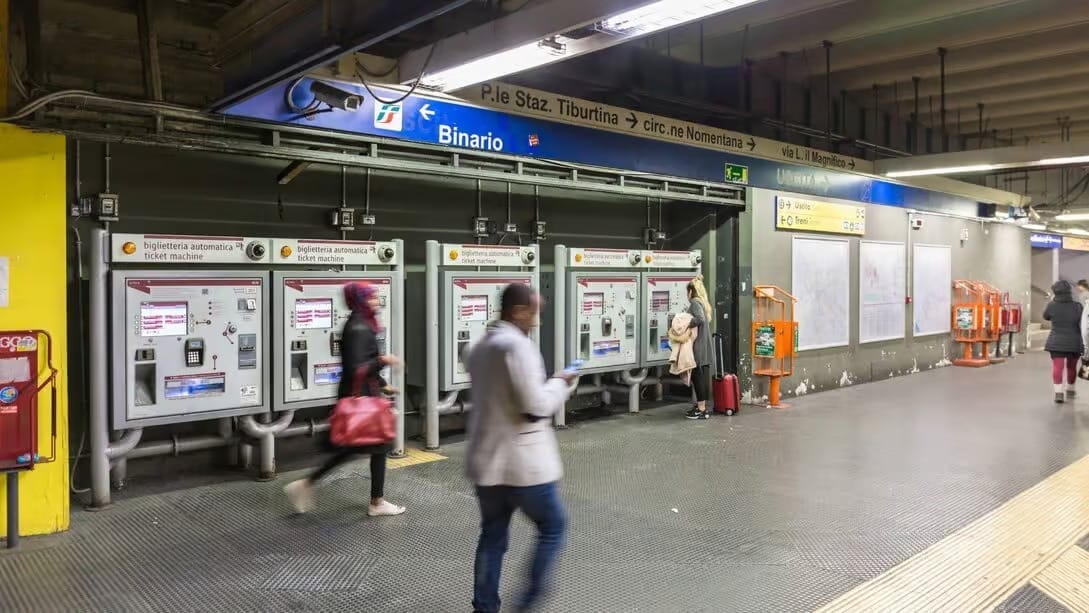
Safety and Precautions (Pickpockets)
Good news: the Rome metro is generally safe, even in the evening. But like in many big cities, pickpockets are around, especially in tourist areas.
- Stay alert at busy stations like Colosseo, Spagna, or Ottaviano.
- Keep your bag zipped and in front of you, especially when the metro is crowded.
- Avoid flashing your wallet or phone unnecessarily.
Quick Tip: Rome Pickpockets often work in groups. If someone bumps into you, check your belongings right away.
How to Avoid Rush Hours
Locals mostly use the metro to commute, which means:
- Rush hours: between 7:30–9:30 am and 5:30–7:30 pm.
- During these times, trains are packed, and you might have to let a few pass before getting on.
👉 If you can, plan your sightseeing outside of peak hours. Bonus: tourist attractions are also less crowded earlier in the day!

Alternatives to the Rome Metro: Bus, Tram, Walking, E-scooters
Sometimes, the metro doesn’t take you exactly where you want to go. But no worries, Rome has plenty of alternatives:
- Buses: Useful for reaching neighborhoods not served by the metro, like Trastevere or for getting to the Vatican at night.
- Trams: Less common but handy. For example, Tram 8 is great for Trastevere.
- Walking: Rome is an open-air museum. Many major sites are within walking distance, and strolling often gives the best views.
- E-scooters and bikes: Apps like Lime or Dott offer scooters and e-bikes. Great for short rides, but watch out for cobblestones!
My tip: Combine metro and walking. For example, take the metro to Colosseo, explore the Forum, then walk to Piazza Venezia. You'll see a lot more than if you stay underground the whole time.
Future Projects of the Rome Metro
If you feel that the Rome metro is limited compared to other major European capitals, you're not alone, but big upgrades are on the way. Over the next few years, new lines and stations are set to transform how people move around the Eternal City.
Extension of Line C (T2 section)
This is the flagship project. Approved on June 27, 2025, the T2 extension of Line C will add four strategic new stations between Piazza Venezia and Viale Mazzini:
- Chiesa Nuova → Located right on Corso Vittorio Emanuele II. Built across 6 underground levels, it will reach a depth of 43 meters.
- San Pietro → Situated beneath the gardens of Castel Sant’Angelo. It will be Rome’s deepest metro station (48 meters), allowing trains to pass under the Tiber River.
- Ottaviano → A direct connection with Line A, making it much easier to get between the Vatican and the city center.
- Clodio/Mazzini → In the vibrant Vittoria district, 33 meters below ground.
This 4 km extension will make Line C a true central axis, connecting Rome’s eastern suburbs, the historic center (Piazza Venezia), and the Vatican area.
Bonus: Two of these new stations will be “archaeo-stations”, featuring exhibition spaces showcasing ancient remains uncovered during the excavations.
📅 Timeline: Construction is expected to begin in 2026, with service launching around 2035. It’s a long wait, but once complete, Line C will become a key route through the heart of Rome.

T1 Extension Toward Farnesina
At the same time, plans for the T1 extension of Line C are also progressing. This section will extend the line northwest to Farnesina, passing by the Auditorium Parco della Musica, one of Rome’s top cultural venues.
📅 Construction is expected to begin in summer 2026.
A Fourth Line (Line D): Still on Hold
You might have heard of the proposed Line D, which was meant to connect southwest Rome to the northeast, covering some of the busiest neighborhoods.
👉 For now, the project is on hold due to lack of funding, but it remains part of the city’s long-term transport strategy.
Modernization and Accessibility Improvements
Beyond new stations, Rome is also investing in upgrading its existing metro system to improve the experience for all riders:
- Modernizing older trains to make rides smoother, more comfortable, and more reliable.
- Improving accessibility, with more elevators and escalators to support travelers with reduced mobility.
- Expanding mobile apps and digital tools, including real-time schedules and route planners to help you move around more efficiently.
Rome Metro FAQ: Your Top Questions Answered

Is the Rome Metro safe for tourists?
Yes, the Rome Metro is generally safe, even at night. You can take it without worry after an evening out in the city center. The main thing to watch out for is pickpockets, especially in busy stations like Colosseo or Spagna. Keep your bag in front of you and your valuables secure. As long as you stay alert, you’ll be fine.
Does the metro in Rome run all night ?
Unfortunately, Rome's metro does not operate 24/7. It usually closes around 11:30 PM on weekdays and 1:30 AM on weekends. But don’t worry—night buses take over once the metro shuts down. They run along the city’s main routes, so you can still get back to your hotel or Airbnb after a late night out.
Can I use the same ticket for the metro, bus, and tram in Rome?
Yes! That’s one of the best things about Rome’s transport system. Whether you take the metro, bus, or tram, your ticket or travel pass is valid across all of them—as long as it’s still within the time limit (e.g., 100 minutes for a standard BIT ticket). This makes it super easy to combine different transport modes in one day.
Does the Rome Metro accept Apple Pay?
Yes, you can use Apple Pay to travel on the Rome Metro. Thanks to the Tap&Go system, contactless payments are accepted directly at the gates.
That means you can simply tap your iPhone or Apple Watch, and €1.50 will be charged for a 100-minute journey that includes metro, buses, and trams. Just remember to use the same device throughout your trip to ensure the system calculates your fare correctly.
Can you buy Rome metro tickets online?
Yes, you can buy Rome metro tickets online. The easiest way is through the official apps like TicketAppy or Roma Mobilità, which allow you to purchase and activate digital tickets directly on your phone.
These tickets work just like paper ones and are valid across metro, bus, and tram networks. If you’re planning your trip in advance, you can also purchase multi-day passes or Rome tourist cards (like the Roma Pass or OMNIA Card) online, which include unlimited public transport use for a set number of days.
What’s the best metro station for visiting the Vatican?
The most convenient station to reach the Vatican is Ottaviano on Line A. It’s about a 10-minute walk to St. Peter’s Square and the Vatican Museums. You can also get off at Cipro (also on Line A), which is just a bit farther but often less crowded, making it a good alternative if you want to avoid the crowds heading to Ottaviano.
Is the Rome Metro family-friendly?
Yes, but you’ll need a bit of planning. If you're traveling with a stroller, be aware that not all stations have elevators, especially on Lines A and B. Line C is newer and generally more accessible.
Kids usually love riding the metro (and it saves them from walking in the heat!), but be sure to bring water and have a backup plan in case an elevator is out of service. Overall, the Rome Metro is a good transport option for families, as long as you're ready to handle a few stairs and occasional crowds during rush hour.
Fanny is a music and travel lover who has been visiting Rome since 2012. She is the founder and main editor of the Roma Pass blog and she like to share the best things to do in Rome.

What’s missing is a map showing the area around each Metro station. I haven’t yet found the closest station to the Marriott Flora hotel.
Hi I arrive Rome at the Airport Nov. 2 and need to get to the Port Civitavecchia ………….I have lost of time the boat leaves at 5 pm
Can I take a train directly to the Civitavecchia
or do I nee to take a train to the Train station in Rome………………..and then take a train to the Port…………………………
Thank you. Can I buy my ticket ahead of time?